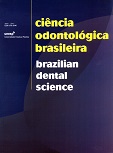Avaliação da superfície de materiais resinosos expostos ao óxido de alumínio
DOI:
https://doi.org/10.14295/bds.2007.v10i4.288Abstract
O objetivo deste estudo foi avaliar o efeito da deposição de óxido de alumínio sobre restaurações resinosas adjacentes a área tratada pelo sistema de abrasão a ar. Foram utilizados 10 terceiros molares devidamente seccionados e incluídos em cera utilidade deixando exposta a face vestibular. Em cada espécime confeccionou-se com a caneta de alta rotação, 4 preparos cavitários de aproximadamente 2mm de diâmetro, eqüidistantes de uma linha central demarcada na cera. As 40 cavidades foram restauradas aleatoriamente com resina composta (Silux-3M) e selante resinoso (Fluoroshield- Dentsply). Em seguida, réplicas de cada espécime foram obtidas pela moldagem com silicone (Imprint II-3M) e modelo em resina epóxi (Stycast 1266- Emerson & Cummings). Na seqüência, foram feitas 2 aplicações de 15s do jato abrasivo na parte central dos espécimes, utilizando-se o aparelho PrepStar® regulado a 80 psi, com ponta ativa de 45º e 0,48mm de diâmetro interno posicionada a 5mm da superfície. Ao final de cada aplicação, as superfícies foram lavadas, secas e moldadas novamente. Todas as réplicas foram avaliadas em MEV por 2 examinadores calibrados que fizeram uma avaliação cega quanto ao tipo de restauração. Os dados tabulados em escores foram analisados estatisticamente por análise de variância de Friedman. Os resultados evidenciaram que não houve diferença estatística significativa entre as superfícies das restaurações analisadas antes e após a utilização do jato abrasivo (p>0,05). Uma vez que o jato de óxido de alumínio não foi aplicado diretamente sobre as restaurações, provavelmente a baixa energia cinética das partículas periféricas não foi capaz de produzir alterações em suas superfícies.Downloads
Downloads
Published
How to Cite
Issue
Section
License
Brazilian Dental Science uses the Creative Commons (CC-BY 4.0) license, thus preserving the integrity of articles in an open access environment. The journal allows the author to retain publishing rights without restrictions.
=================




























